 |
 |
|
|
Photographers of Japan Vol.15 "Kitai Kazuo - Capturing ga scene I once sawch"
Kitaifs photographs began to change from the 1970s onwards. Following his serial publication of gOkinawa Wanderingsh (1972) and gFrance Wanderingsh (1973) in Asahi Camera, he began to serialize gTo the Villageh from January 1974. gTo the Villageh continued until December 1975 and was awarded the first Kimura Ihei Award in 1976. Including the follow up of gAnd Then to the Villageh (January 1976 - June 1976), this series spanned 4 years and 41 issues of Asahi Camera Magazine and is one of Kitaifs representative works. The theme of gTo the Villageh was the landscape of rural Japan as it changed with the rapid modernization that came with the economic boom of the 60s and 70s. However, Kitaifs purpose was not to comment on agricultural issues or leave folkloric record - at most, he was a passerby, capturing the scenes from his travels with a certain distance. As a result, his works capture nostalgic memories of scenes many Japanese consider the Japan of the past. Kitai continued to develop as a photographer after his completion of gTo the Villageh. He presented further works like gThe People of Sakaigawah (1979), a collection of photos taken in Urayasu, Chiba Prefecture; gTale of Shinsekaih (1981), which captured the area around Osakafs Tsutenkaku; and gFunabashi Storyh (1989), which pointed the camera at the people of Funabashi, Chiba, where he moved to in 1989. In the 1990s he spent a long period in the modernizing city of Beijing and compiled his recordings into the photo collection gBeijing 1990sh (2004). In her essay gRegular lifeh for the catalog of the Tokyo Photographic Art Museumfs exhibition gKitai Kazuo - A scene I once sawh (Nov. 2012 ~ Jan. 2013), the curator Fujimura Satomi wrote, gKitai Kazuo is a photographer who documents regular lifeh. The gaze which Kitai cast on this gdaily lifeh seems to be growing deeper and deeper from the 2000s onwards.
 Kitai Kazuo "Kuwatorimura, Niigata from 1970s Japan" 1981 Gelatin silver print 15.8×23.6cm BacknumberVol.16 "Ogawa Takayuki (1938 - 2008) - explorer of shape through photography"Vol.15 "Kitai Kazuo - Capturing a scene I once saw" Vol.14 "Kazama Kensuke" Vol.13 "Narahara Ikko - Double Vision" Vol.12 "Q Ei and Vol.11 "Fukuhara Shinzo 1883-1948 -- Japanese Landscape Photography" Vol.10 "The city observerfs gaze Akihiko HIRASHIMA (1946~)" Vol.9 "Hitoshi FUGO 1947- -- The unusual world of works which fuses thought and technique" "ETSURO ISHIHARA - THE EXTRAORDINARY GALLERIST WHO TURNED PHOTOGRAPHY TO ART" Vol.8 "Iwata NAKAYAMA (1895-1949)" Vol.7 "KISEI KOBAYASHI (1968-)" Vol.6 "Tamiko NISHIMURA (1948-)" Vol.5 "Shigeo GOCHO (1946-83)" Vol.4 "Shoji UEDA -Locality open to the world-" Vol.3 "Yu OGATA, ICHIRO OGATA ONO -Dyslexia's picture of the world-" Vol.2 "Eikoh Hosoe's theatrical imagination" Vol.1 "maroon" -- Whereabouts of new works by Hiroshi Osaka
|
| Gallery TOKI NO WASUREMONO / WATANUKI INC. LAS CASAS, 5-4-1, Hon-komagome, Bunkyo-ku, Tokyo 113-0021 JAPAN Tel +81-3-6902-9530 Fax +81-3-6902-9531 E-mail:info@tokinowasuremono.com http://www.tokinowasuremono.com/ Open Tuesday-Saturday 11:00-19:00 Closed on Sundays, Mondays, National Holidays Copyrighticj2012 TOKI-NO-WASUREMONO^WATANUKI@ INC. All rights reserved. |